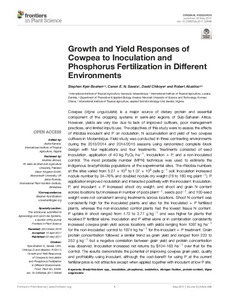| dc.contributor.author | Boahen, S. |
| dc.contributor.author | Savala, C.E.N. |
| dc.contributor.author | Chikoye, D. |
| dc.contributor.author | Abaidoo, R.C. |
| dc.date.accessioned | 2019-12-04T11:08:33Z |
| dc.date.available | 2019-12-04T11:08:33Z |
| dc.date.issued | 2017-05-03 |
| dc.identifier.citation | Boahen, S., Savala, C.E.N., Chikoye, D. & Abaidoo, R. (2017). Growth and yield responses of cowpea to inoculation and phosphorus fertilization in different environments. Frontiers in Plant Science, 8, 646. |
| dc.identifier.issn | 1664-462X |
| dc.identifier.uri | https://hdl.handle.net/20.500.12478/1855 |
| dc.description | Open Access Journal; Published: 03 May 2017 |
| dc.description.abstract | Cowpea (Vigna unguiculata) is a major source of dietary protein and essential component of the cropping systems in semi-arid regions of Sub-Saharan Africa. However, yields are very low due to lack of improved cultivars, poor management practices, and limited inputs use. The objectives of this study were to assess the effects of rhizobia inoculant and P on nodulation, N accumulation and yield of two cowpea cultivars in Mozambique. Field study was conducted in three contrasting environments during the 2013/2014 and 2014/2015 seasons using randomized complete block design with four replications and four treatments. Treatments consisted of seed inoculation, application of 40 kg P2O5 ha-1, inoculation + P, and a non-inoculated control. The most probable number (MPN) technique was used to estimate the indigenous bradyrhizobia populations at the experimental sites. The rhizobia numbers at the sites varied from 5.27 × 102 to 1.07 × 103 cells g-1 soil. Inoculation increased nodule number by 34–76% and doubled nodule dry weight (78 to 160 mg plant-1). P application improved nodulation and interacted positively with the inoculant. Inoculation, P, and inoculant + P increased shoot dry weight, and shoot and grain N content across locations but increases in number of pods plant-1, seeds pod-1, and 100-seed weight were not consistent among treatments across locations. Shoot N content was consistently high for the inoculated plants and also for the inoculated + P fertilized plants, whereas the non-inoculated control plants had the lowest tissue N content. P uptake in shoot ranged from 1.72 to 3.77 g kg-1 and was higher for plants that received P fertilizer alone. Inoculation and P either alone or in combination consistently increased cowpea grain yield across locations with yields ranging from 1097 kg ha-1 for the non-inoculated control to 1674 kg ha-1 for the inoculant + P treatment. Grain protein concentration followed a similar trend as grain yield and ranged from 223 to 252 g kg-1 but a negative correlation between grain yield and protein concentration was observed. Inoculation increased net returns by $104–163 ha-1 over that for the control. The results demonstrate the potential of improving cowpea grain yield, quality and profitability using inoculant, although the cost-benefit for using P at the current fertilizer price is not attractive except when applied together with inoculant at low P site. |
| dc.description.sponsorship | United States Agency for International Development |
| dc.format.extent | 1-13 |
| dc.language.iso | en |
| dc.subject | Bradyrhizobium Spp |
| dc.subject | Inoculation |
| dc.subject | Phosphorus |
| dc.subject | Nodulation |
| dc.subject | Nitrogen Fixation |
| dc.subject | Protein Content |
| dc.subject | Vigna Unguiculata |
| dc.subject | Cowpeas |
| dc.title | Growth and yield responses of cowpea to inoculation and phosphorus fertilization in different environments |
| dc.type | Journal Article |
| dc.description.version | Peer Review |
| cg.contributor.affiliation | International Institute of Tropical Agriculture |
| cg.coverage.region | Africa |
| cg.coverage.region | Southern Africa |
| cg.coverage.country | Mozambique |
| cg.isijournal | ISI Journal |
| cg.authorship.types | CGIAR single centre |
| cg.iitasubject | Cowpea |
| cg.iitasubject | Grain Legumes |
| cg.iitasubject | Soil Fertility |
| cg.journal | Frontiers in Plant Science |
| cg.howpublished | Formally Published |
| cg.accessibilitystatus | Open Access |
| local.dspaceid | 83388 |
| cg.targetaudience | Scientists |
| cg.identifier.doi | http://dx.doi.org/10.3389/fpls.2017.00646 |

